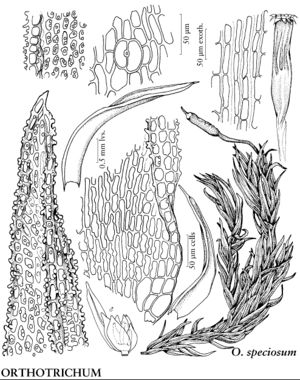Orthotrichum speciosum
in J. Sturm et al., Deutschl. Fl. 2 (17): 5. 1819.
Plants 0.8–5 cm. Stem-leaves loosely erect, usually slightly contorted or curved when dry, lanceolate to narrowly lanceolate, 3–4 mm; margins revolute nearly to apex, entire; apex acuminate to narrowly acute; basal laminal cells elongate, walls thick, nodose or wavy; distal cells 7–13 µm, 1-stratose, papillae 1–3 per cell, conic or 2-fid, large. Specialized asexual reproduction absent. Sexual condition gonioautoicous. Seta 1–3 mm. Capsule exserted to rarely emergent, cylindric to ovate-cylindric when mature, 1.5–2.4 mm, slightly 8-ribbed to mid capsule; stomata superficial; peristome double; prostome absent; exostome teeth 8, separate to base, recurved, acute, coarsely papillose; endostome segments 8, well developed, usually present when capsule old and dry, thick, stout, of 2 rows of cells, narrower than exostome teeth, yellowish-brown, coarsely papillose. Calyptra conic-oblong, smooth, hairy, hairs finely papillose. Spores 13–26 µm.
Habitat: Coniferous and deciduous trees, rock
Elevation: low to high elevations (10-2000 m)
Distribution

Greenland, Alta., B.C., Man., N.B., Nfld. and Labr., N.W.T., N.S., Nunavut, P.E.I., Que., Sask., Yukon, Alaska, Calif., Colo., Idaho, Mich., Minn., Mont., Nev., N.H., N.Y., Oreg., Utah, Wash., Wyo., Europe, n Asia, n Africa
Discussion
Orthotrichum speciosum is primarily western and Arctic in distribution; the plants are distinguished by their ribbed capsules, large size, and more slender leaf apices.
Selected References
None.
Lower Taxa
"narrower" is not a number.
